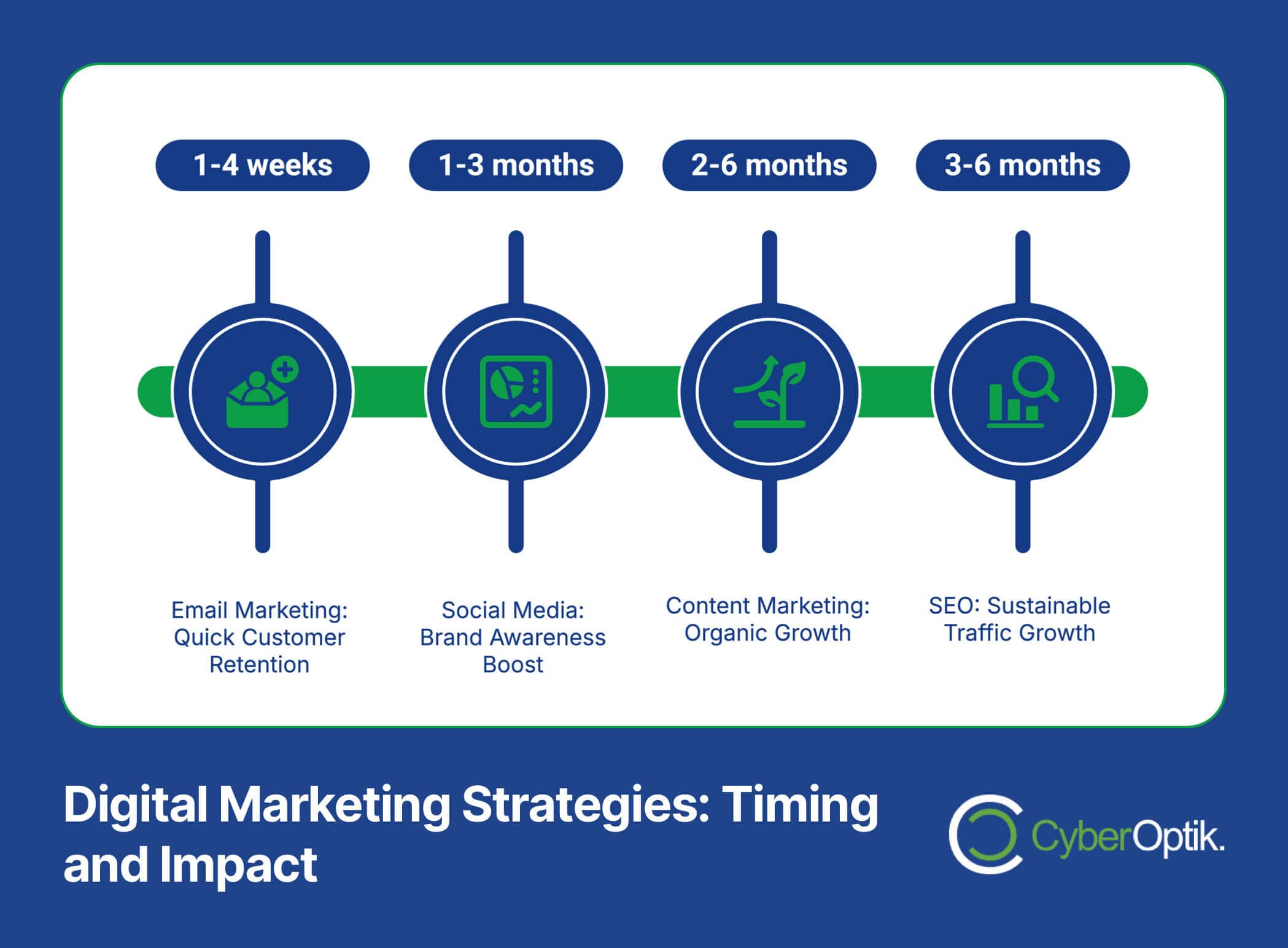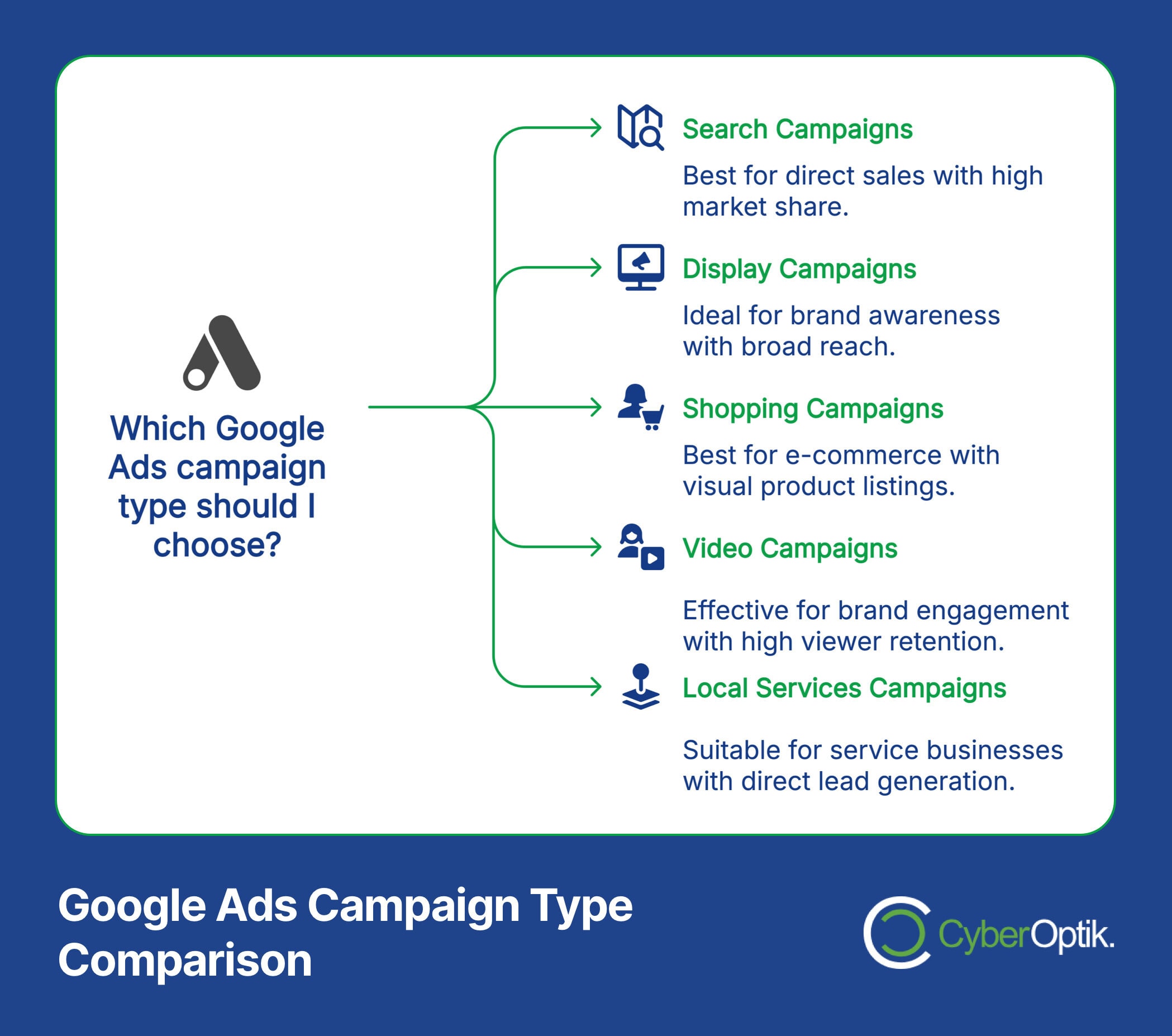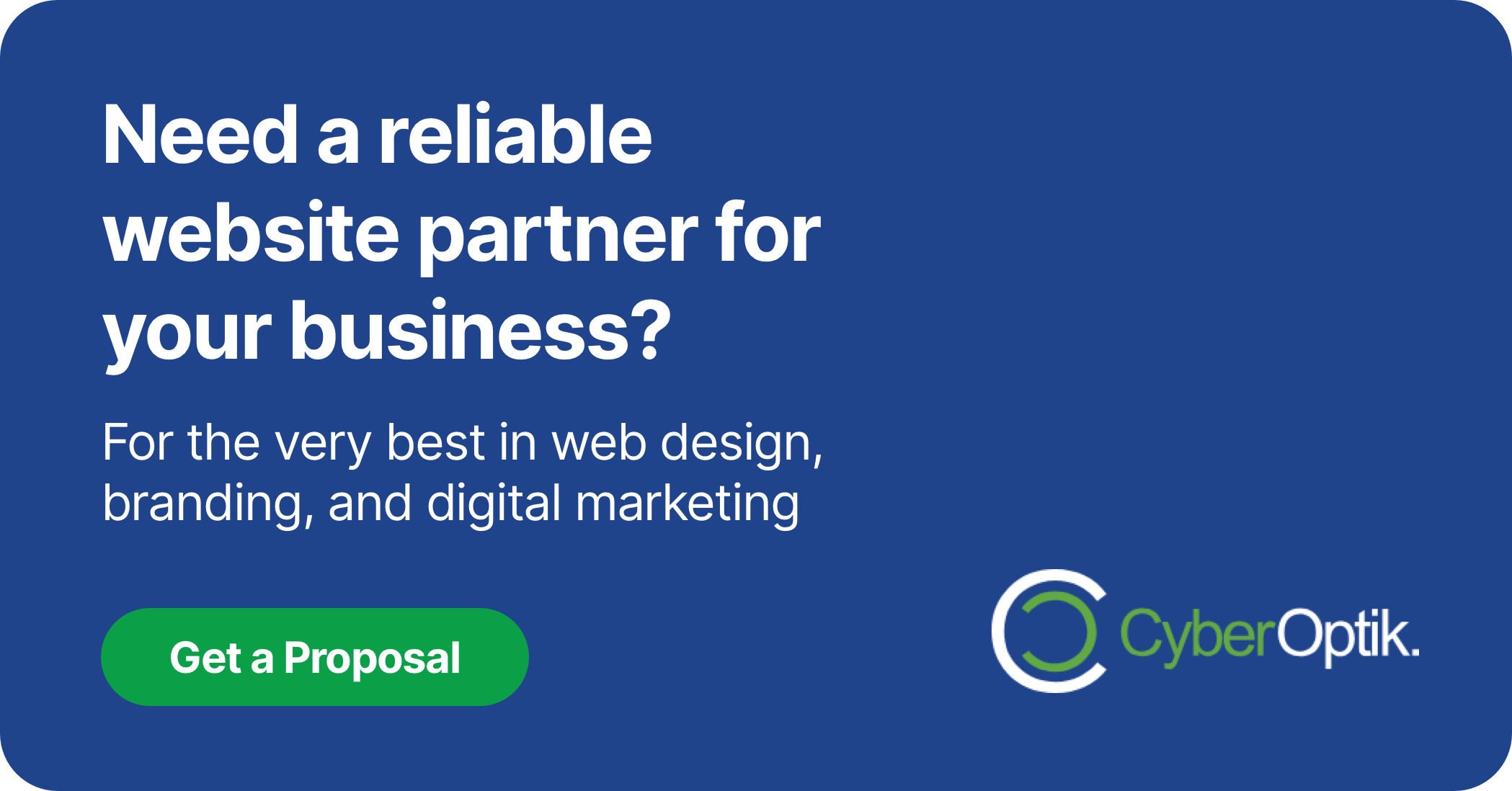The digital world continues to evolve rapidly for businesses in Chicago and beyond. We’ve seen firsthand how the right marketing approach can transform an underperforming website into a powerful business asset. In today’s competitive online environment, having an effective marketing strategy isn’t just helpful – it’s essential for survival.
Did you know that 93% of all website traffic comes from search engines? (Source: WebFX) This statistic alone demonstrates why developing comprehensive marketing strategies should be a priority for any online business. The right tactics can dramatically increase your visibility, drive targeted traffic, and boost conversion rates.
In this guide, we’ll explore the most effective marketing strategies for online businesses, breaking down exactly how each approach can help you achieve better results. From SEO and paid advertising to content marketing and social media, we’ll cover practical tactics you can implement right away.
Understanding the Digital Marketing Industry
New platforms emerge, algorithms update, and consumer behaviors shift. Staying relevant requires both adaptability and a solid foundation in marketing principles.
Success in digital marketing comes from understanding your specific audience and their needs. The businesses we work with in Chicago often start with broad strategies. They quickly learn that targeted approaches yield better results.
Research shows that 89% of marketers report SEO success as a key performance metric for their digital efforts. (Source: Optimizely) This highlights how critical search visibility has become in the marketing mix. Yet many businesses struggle to integrate different marketing channels effectively.

Before diving into specific strategies, let’s examine how different marketing channels compare in terms of effectiveness, timeline, and business applications:
| Marketing Channel | Time to Results | Cost Investment | Longevity of Results | Best For |
|---|---|---|---|---|
| SEO | 3-6 months | Medium-High | Long-lasting | Sustainable traffic growth |
| PPC Advertising | Immediate | High | Only while running | Quick results, specific campaigns |
| Content Marketing | 2-6 months | Medium | Long-lasting | Brand authority, organic growth |
| Social Media | 1-3 months | Low-Medium | Short-Medium | Brand awareness, community building |
| Email Marketing | 1-4 weeks | Low | Medium | Customer retention, direct conversions |
Understanding these differences helps you create realistic expectations and allocate resources appropriately. Now, let’s explore each strategy in detail.
Search Engine Optimization (SEO): Foundation for Organic Growth
SEO forms the backbone of sustainable online growth. It drives consistent, quality traffic to your website without ongoing payment for each visitor. Data shows that SEO generates over 1,000% more traffic than organic social media. (Source: Optimizely) This massive difference makes search engine optimization an essential strategy for any online business.
We often break down SEO into three core components: technical SEO, on-page optimization, and off-page factors. Each plays a vital role in improving your visibility in search results.
Technical SEO Fundamentals
Technical SEO focuses on your website’s infrastructure. Search engines need to easily crawl, index, and understand your site. Technical issues can prevent even the best content from ranking properly.
Key technical factors include:
- Site speed optimization – Faster websites rank better and convert more visitors
- Mobile responsiveness – Sites must perform flawlessly on all devices
- Secure connection (HTTPS) – Essential for both rankings and user trust
- Proper site structure – Clear navigation helps both users and search engines
- Schema markup – Helps search engines understand your content context
Mobile devices account for 68% of website traffic, making mobile optimization crucial for SEO success. (Source: Digital Defynd) Websites that perform poorly on mobile devices see significantly higher bounce rates and lower conversion rates.
On-Page SEO Strategies
On-page SEO involves optimizing individual pages to rank higher and earn more relevant traffic. This includes optimizing content, meta tags, headings, and internal linking structure.
Start with thorough keyword research to understand what your target audience is searching for. Focus on topics relevant to your business that also have reasonable search volume and competition levels.
Quality content remains the foundation of effective SEO. Create comprehensive resources that answer users’ questions better than competing pages. Include relevant keywords naturally throughout your content, especially in titles, headings, and the first paragraph.
Local SEO for Chicago Businesses
For businesses serving specific geographic areas, local SEO provides enormous opportunities. This includes optimizing your Google Business Profile, building local citations, and creating location-specific content.
Local search has become increasingly important as 93% of users research local businesses via mobile. (Source: Omnicore Agency) This makes local SEO essential for businesses with physical locations or service areas.
Pay-Per-Click Advertising: Driving Immediate Traffic
While SEO builds long-term organic traffic, what is PPC in marketing and how does it complement organic efforts? Pay-per-click advertising delivers immediate visibility and traffic. It allows you to appear at the top of search results instantly for your target keywords.
PPC accounts for 9% of all website traffic but often represents a much higher percentage of conversions. (Source: Optimizely) This makes it an efficient channel for driving qualified leads and sales.
Google Ads Strategies
Google Ads dominates the PPC landscape, accounting for 63.4% of U.S. search traffic referrals. (Source: Optimizely) Effective Google Ads campaigns require careful keyword selection, compelling ad copy, and optimized landing pages.

Let’s compare different Google Ads campaign types to understand their applications:
| Campaign Type | Best For | Targeting Options | Typical Cost | Key Metrics |
|---|---|---|---|---|
| Search | Direct response, sales | Keywords, location, device | Medium-High | CTR, Conversion Rate |
| Display | Brand awareness | Interests, topics, placements | Low | Impressions, Engagement |
| Shopping | E-commerce sales | Product attributes | Medium | ROAS, Conversion Value |
| Video | Brand awareness, engagement | Demographics, interests | Medium | View Rate, Engagement |
| Local Services | Service businesses | Service type, location | Medium-High | Leads, Cost Per Lead |
Each campaign type serves different goals. Select the right approach based on your specific business objectives and target audience.
Social Media Advertising
Social media platforms offer powerful advertising options with precise audience targeting. Facebook ads generate 80% higher brand awareness compared to other digital advertising formats. (Source: Optimizely) This makes them particularly effective for building brand recognition.
Different platforms serve different purposes. LinkedIn works well for B2B businesses, while Instagram and TikTok excel for visual products targeting younger audiences. Match your platform choice to your specific audience demographics and behaviors.
Retargeting Campaigns
Retargeting (also called remarketing) shows ads to people who’ve previously visited your website. These campaigns typically have higher conversion rates since they target people already familiar with your brand.
We often see conversion rates 2-3 times higher with retargeting campaigns compared to standard display ads. This makes them an essential component of an effective PPC strategy.
Content Marketing: Creating Value for Your Audience
Content marketing centers on creating and distributing valuable, relevant content to attract and engage a clearly defined audience. It builds trust, establishes authority, and supports both SEO and social media efforts.
The most successful content marketing strategies focus on addressing customer pain points and questions. By providing genuine value, you position your business as a trusted resource rather than just another company selling products or services.
Content Types and Their Applications
Different content formats serve various purposes throughout the customer journey. Here’s how various content types perform across key metrics:
| Content Type | Awareness Stage | Consideration Stage | Decision Stage | Production Difficulty |
|---|---|---|---|---|
| Blog Posts | Excellent | Good | Average | Low-Medium |
| Videos | Excellent | Excellent | Good | Medium-High |
| Case Studies | Poor | Good | Excellent | Medium |
| Ebooks/Guides | Average | Excellent | Good | High |
| Infographics | Excellent | Good | Poor | Medium |
Video content particularly stands out in effectiveness. Research shows that 91% of businesses now use video as a marketing tool. (Source: Optimizely) Furthermore, short-form videos under 90 seconds retain 50% of viewers until the end, making them highly engaging. (Source: Optimizely)
Content Distribution Strategies
Creating great content is only half the battle. You also need effective distribution strategies to ensure your content reaches your target audience. This includes:
- Email newsletters – Send content directly to your subscriber list
- Social media sharing – Distribute on platforms where your audience spends time
- Community participation – Share in relevant forums and groups
- Outreach to influencers – Get industry leaders to share your content
- Content repurposing – Transform one piece into multiple formats
The key is to create a strategic plan that aligns your content with business goals while providing genuine value to your audience. This builds content marketing that generates more leads without feeling pushy or promotional.
Social Media Marketing: Building Brand Presence
Social media has become an essential channel for brand building, customer engagement, and traffic generation. An impressive 96% of small businesses now use social media for marketing purposes. (Source: Shopify) This widespread adoption reflects its effectiveness across industries.
Rather than trying to maintain a presence on every platform, focus your efforts where your target audience is most active. Each platform has unique characteristics that lend themselves to different industries and content types.
Platform Selection Strategy
TikTok has emerged as the most popular platform for influencer marketing, with 69% of marketers using it for campaigns. (Source: DSMN8) However, this doesn’t mean it’s right for every business. Your platform selection should match your audience demographics, content capabilities, and business goals.
Consider these factors when choosing social media platforms:
| Platform | Primary Demographics | Content Format | Business Use Case | Posting Frequency |
|---|---|---|---|---|
| 25-54 age range | Mixed media | Community building, local business | 3-5 times weekly | |
| 18-34 age range | Visual (photos, videos) | Product showcase, lifestyle brands | 4-7 times weekly | |
| 25-65 professionals | Text, business content | B2B, recruiting, thought leadership | 2-5 times weekly | |
| TikTok | 16-34 age range | Short videos | Brand awareness, viral potential | Daily |
| 25-49 age range | Text, news, updates | Customer service, news, updates | Daily |
Emerging platforms continue to gain prominence. Reddit, for example, saw its Q3 2024 ad revenue grow by 56% year-over-year. (Source: Sprout Social) This indicates new opportunities on platforms that may have been overlooked in your marketing mix.
Organic vs. Paid Social Strategies
Both organic and paid social media approaches have their place in a comprehensive strategy. Organic posting builds community and establishes your brand voice, while paid advertising expands reach and targets specific audiences.
Social media ad spending is projected to reach $276.7 billion by 2025, reflecting the growing emphasis on paid social strategies. (Source: Sprout Social) This investment trend underscores the effectiveness of paid social media in driving business results.
The most effective approach combines consistent organic posting with strategic paid campaigns. This creates a balanced social media presence that builds relationships while actively driving traffic and conversions.
Email Marketing: Nurturing Customer Relationships
Email marketing remains one of the most effective digital channels, offering an impressive 4,200% return on investment on average. (Source: Optimizely) This exceptional ROI makes email a crucial component of any comprehensive marketing strategy.
The key to email marketing success lies in building a quality list of subscribers who genuinely want to hear from you. Focus on providing value in every email rather than simply promoting products or services.
Email Campaign Types and Performance
Different email campaigns serve various purposes throughout the customer journey. Here’s how they typically perform:
| Campaign Type | Average Open Rate | Average CTR | Best For | Frequency |
|---|---|---|---|---|
| Welcome Series | 50-60% | 20-30% | New subscriber orientation | Automated sequence |
| Newsletters | 15-25% | 2-5% | Regular engagement | Weekly or monthly |
| Promotional | 15-20% | 1-3% | Sales and offers | As needed |
| Abandoned Cart | 40-50% | 10-15% | Recovery of lost sales | Automated trigger |
| Re-engagement | 10-15% | 1-2% | Reactivating inactive subscribers | Targeted campaigns |
Email remains a preferred communication channel for many consumers. Research shows that 60% of consumers prefer to receive brand updates via email over other channels. (Source: Optimizely) This preference makes email particularly valuable for nurturing customer relationships.
Email Marketing Best Practices
To maximize email effectiveness, follow these proven best practices:
- Segmentation – Group subscribers based on behavior, interests, or demographics
- Personalization – Include the recipient’s name and relevant content
- Mobile optimization – Ensure emails display properly on all devices
- Clear CTAs – Include obvious next steps for subscribers
- Value-first approach – Provide useful information before asking for sales
Email automation has transformed what’s possible with limited resources. Setting up triggered emails based on specific user actions enables personalized communication at scale – perfect for businesses of all sizes.
Website Optimization for Conversions
Your website serves as the central hub for all your marketing efforts. Even the best traffic generation strategies will fail if your site doesn’t convert visitors effectively. Website speed optimization is particularly critical, as a 1-second delay in page load time reduces conversions by 7%. (Source: Optimizely)
We’ve seen Chicago businesses transform their results by making strategic website improvements. The most effective changes often focus on simplifying the user journey and removing friction from conversion paths.
Conversion Rate Optimization (CRO) Essentials
Conversion rate optimization involves systematically improving elements of your website to increase the percentage of visitors who take desired actions. This data-driven process focuses on understanding user behavior and testing improvements.
Key areas for CRO include:
- Landing page design – Clear messaging aligned with traffic sources
- Call-to-action optimization – Compelling buttons with action-oriented text
- Form simplification – Reducing fields to minimum necessary information
- Trust indicators – Reviews, testimonials, and security symbols
- Visual hierarchy – Guiding users through content in priority order
Mobile optimization deserves special attention, as 51% of global website traffic now comes from mobile devices. (Source: Omnicore Agency) This means your website must provide an excellent experience across all devices, not just desktops.
Conversion Paths by Traffic Source
Different traffic sources often have different conversion behavior patterns. Understanding these differences allows you to optimize accordingly:
| Traffic Source | Avg. Conversion Rate | Typical Behavior | Optimization Focus |
|---|---|---|---|
| Direct Traffic | 3.3% | High intent, branded searches | Streamlined conversion paths |
| Organic Search | 2.4% | Research-oriented, information seeking | Educational content with clear next steps |
| 4.2% | Engaged audience, specific intent | Dedicated landing pages aligned with email | |
| Paid Search | 3.6% | High intent, specific searches | Message match with ad copy, clear CTAs |
| Social Media | 1.8% | Discovery mode, lower intent | Engaging content, softer conversion goals |
The data shows direct traffic converts at 3.3% on average. (Source: Optimizely) This higher conversion rate for direct traffic highlights the importance of brand awareness efforts that drive direct site visits.
Measuring Marketing Success
Effective measurement forms the foundation of any successful marketing strategy. Without proper tracking and analysis, it’s impossible to know what’s working and what needs improvement.
We recommend establishing clear key performance indicators (KPIs) for each marketing channel. These metrics should align with your overall business objectives rather than focusing solely on vanity metrics like raw traffic numbers.
Essential Marketing Metrics by Channel
Each marketing channel has specific metrics that provide insight into performance. Here are the most important metrics to track by channel:
| Channel | Primary Metrics | Secondary Metrics | Business Impact Metrics |
|---|---|---|---|
| SEO | Organic traffic, rankings | Click-through rate, dwell time | Conversion rate, revenue |
| PPC | Clicks, conversions | CTR, quality score | Cost per conversion, ROAS |
| Content | Page views, time on page | Social shares, comments | Lead generation, conversions |
| Social | Engagement, followers | Reach, impression share | Traffic referred, conversions |
| Open rate, click rate | List growth, unsubscribes | Conversion rate, revenue |
Focus on tracking metrics that connect directly to revenue and business growth rather than just activity metrics. This helps maintain focus on what truly matters for your business.
The Integrated Approach: Maximizing Impact
The most successful marketing strategies don’t treat channels as separate silos. They integrate multiple approaches into a cohesive system. Unfortunately, 70% of marketers lack integrated content strategies across their channels. (Source: Optimizely) This represents a significant missed opportunity.
Integrated campaigns yield 50% higher ROI compared to isolated channel efforts. (Source: Optimizely) This substantial performance difference demonstrates why integration should be a priority for any marketing strategy.
An integrated approach creates multiple touchpoints with potential customers across channels. For example, someone might discover your business through social media, research your services through organic search, and finally convert after receiving an email. Attributing that conversion to a single channel misses the bigger picture.
Building an Integrated Marketing Framework
To create a truly integrated marketing strategy:
- Start with clear business objectives that guide all marketing activities
- Develop consistent messaging that works across all channels
- Create content that can be adapted for multiple platforms
- Ensure visual branding remains consistent everywhere
- Implement proper tracking to understand cross-channel customer journeys
This approach ensures all your marketing efforts work together rather than competing or creating disconnected experiences for potential customers.
Your Marketing Strategy Roadmap
Effective marketing for online businesses requires a strategic approach that combines multiple channels working together. The most successful strategies typically blend SEO, PPC, content marketing, social media, and email into a cohesive system that guides prospects through the buyer’s journey.
Remember that marketing success doesn’t happen overnight. Some channels, like SEO, require patience and consistent effort before showing significant results. Others, like PPC, can drive immediate traffic but require ongoing investment.
We recommend starting with a thorough analysis of your current digital presence. Identify gaps and opportunities before prioritizing specific strategies. Focus on a few channels initially, then expand as you build momentum and learn what works best for your specific business.
As a Chicago digital marketing agency, we’ve helped hundreds of businesses implement these strategies successfully. Whether you’re just getting started or looking to take your existing marketing to the next level, these approaches provide a solid foundation for sustainable growth.
Ready to transform your online marketing? Contact our team for a free consultation to discuss how these strategies can be tailored to your specific business needs.




